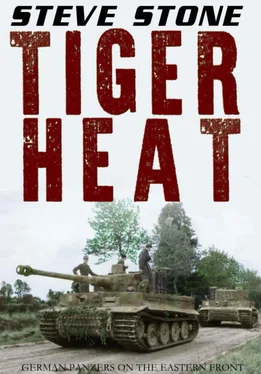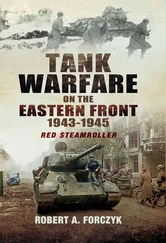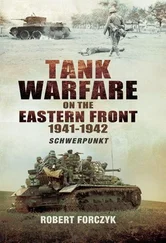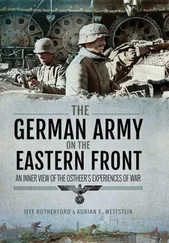The first 76mm shell from a T-34 had hit the Tiger on the rear, near the tracks and the idler wheel. It was a HE (High Explosive) round letting out a bright white flash as it exploded. The force of the blast caused the entire rear wheel of the Tiger fly off and land in the snow a few feet away. This wheel took at least three men to lift off and had been launched like a tiddly wink by the explosion. As the wheel broke away, it shattered the pins holding the tracks together, causing the tracks to break apart and hang limply off the wheels. The momentum of the tank causing the tank to slew off to the right out of control. Sending a huge cloud of snow up into the air. A second shot had shattered the front drive sprocket. This opening shot had pretty much decided the outcome of this tank duel.
The third round hit into the side causing shrapnel to enter the hull. The round had entered the thinner rear armour before hitting the engine and bouncing back up through the engine grilles. This caused several lacerations to the gunners’ torso. His uniform now shredded and his jacket partially hanging off. The driver had been knocked out cold after the second round had hit the right-hand track just before the front sprocket.
The final AP (Armour Piercing) round fired by a T-34 at close range. Penetrated the rear hull and entered the crew compartment before bouncing around and causing fatal shrapnel wounds to the crew. Petrol poured out of ruptured fuel lines as the first glimmer of flame began to lick around the engine.
Inside the tank was a bloody mess. Flesh and limbs had been scattered in all directions and the crew had died a horrific death. The tank commander’s head now lay on the crisp white snow his eyes wide open starring into the blue sky after his body had been partially ejected and his head had come clean off. Through a crack in the front corner, the driver was slumped down missing an arm.
The crew had fought valiantly, knocking out over 30 tanks during their time on the Eastern Front. Shells from T-34 tanks had just bounced off the frontal armour as had rockets fired by Russian infantry. The Tiger had shown what a formidable weapon it truly was, but it was vastly outnumbered and low on fuel after becoming separated from its column. After a couple of minutes, the fire took hold and the Tiger was now fully ablaze thick black smoke reaching far into the clear blue sky. Within an hour what was once a formidable tank, was now a sooty black and rusty brown coloured hull. It had become the crematorium and final resting place of a heroic German tank crew. Their remains finally interned in mass unmarked graves in the vastness of the Soviet Union.
Although, in actual combat only about a quarter of tanks hit in battle caught fire and burned out. Even immobilised or ‘knocked out’ tanks could often be repaired either on or off the battlefield. The actual casualty rate was around 0-2 for every tank taken out of action by enemy fire. A crew could be knocked out several times during an operation. During the early years of the war on the Eastern Front, Red Army crews would often abandon their tanks once knocked out and stroll back to camp. This was until a directive that stated if they did not return with their tank they would be sent to penal units. This meant Red Army crews stayed with their damaged tanks until they could be repaired or recovered, reducing tank loses.
The first attack by a tank took place on September 15, 1916 by a British Mk1 tank with limited success. The Mk1 had an unusual rhomboidal shape, which was to give a long track run as possible to aid in crossing wide trenches. Many of the Mk1 tanks still became stuck or broke though. Initially used in very small numbers on the Somme in September 1916. On November 20, 1917, the first tank offensive was a launched when 476 British tanks made a 12-mile breach into the strongest sector of the Hindenburg Line. The Germans produced only 13 tanks during the First World War. By July 2018, the British had 1,184 tanks. The first tank v tank battle took place on April 24, 1918, when three British Mk IVs engaged three German heavy A7Vs. One AV7 was knocked out, although not before the Germans had disabled three British Whippet tanks.
The lessons learnt in the First World War were not lost on Germany’s military leaders under the Nazi regime. General Hans Seekt guided the development of the tank as an instrument of mobile warfare and put together the Blitzkrieg (Lightning War) tactics in which German Panzer tank divisions, preceded by ground attack aircraft like the Ju 87 Stuka dive bomber. The Stukas went deep into enemy territory to create corridors for the mechanised infantry to exploit. These tactics worked well in the Battle of France and in North Africa; although in North Africa the Germans were ultimately thwarted by Allied air supremacy.
The Blizkreig tactics also worked well during the early phase of the attack on Russia. The Germans received a shock though when they came up against the Soviet KV-1 and T-34 tanks. Their 76 mm could penetrate German armour whilst remaining immune to German anti-tank weapons. To counter this the Germans quickly developed a new generation of heavily armed tanks. Two of these were the Tiger and Panther tanks…
November 1942
As the sun rose on another cold and harsh day. Tigers from the 11 thCompany of III Abteilung made their way out of the gully they had used to conceal themselves in overnight. Klaus, the driver of the lead tank looked at his basic instruments. The Tigers main instruments on the driver compartments right hand side contained a dip or dimmer switch. Then a large dial next to the switches which was the revolution gauge. To the right of that at the top a speedometer and odometer combined. Below that, a slightly smaller oil pressure dial. The final dial on Klaus’s instrument panel was the coolant temperature gauge and beneath that was the ignition switch and light.
Klaus and the other drivers flicked their ignition switch and tried to start the mighty Maybach V12 engine. The Tiger was steered via a half steering wheel made of metal and wrapped in black tape. In a similar fashion to the tape wrapped around a like a 1980’s road bike handlebar. The driver only had a small viewing slit to look through which took away some of his peripheral as well as lateral vision.
Each tank struggled to turn over in the intense cold and even when started the tracks had to unstick themselves from the frozen ground, before moving forward and shedding all the icicles that had formed on the wheels and tracks overnight. These icicles shattering into thousands of glittering pieces of what looked like shattered glass.
The bright sunlight revealed every crease on Max’s battle weary face as he stood up in his cupola listening intently to his headphones. As the engines burst into life one by one, the smell of the exhaust seeped into the tanks and mixed with the smell of gun oil along and men whom had not washed for days. Standing up Max had a commanding view of the battlefield and could pass down orders to the rest of the crew. German commanders liked to stand up and out of the tank for a better view. Russian commanders did the reverse limiting their view through small sights.
Klaus, manoeuvred his heavy Tiger around some rocks using all his skill on the slippery surface before climbing up a gentle slope and onto the rough cart track. The engine roared as it took the strain of pushing 57 tons of tank up a slope. The tracks were the widest track of any tank use in anger in WWII. Wide tracks helped reduce the ground pressure inflicted by the Tigers heavy weight. The tracks bit into the snow with a loud crunching noise slowly propelling the Tiger slowly up the 40-degree slope. Looking out from the thin slot the tank Klaus could see right up into the grey sky, heavy with snow.
Читать дальше












